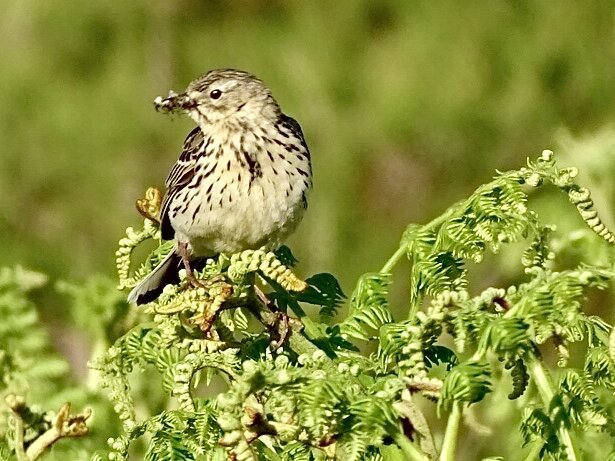Cuckoo
Well, these are very strange days indeed, but a few summer visitors have still made it to the shores of Loch Lomond despite lockdown. Standing in a WW2 creator made by a confused and probably terrified Luftwaffe pilot in the May of 1946, I feel sure the tourist I’m thinking about would have arrived on schedule despite the dangers back then too.
The Cuckoo has been making its long pilgrimage for hundreds if not thousands of years to Carman Moor.
Wintering in the rainforests of the Congo they make their way back to our hills via the Sahara Desert, Spain and France, usually arriving here at the beginning of April.
So, I decided to get myself up to the Stoneymollin to see if I could actually see one rather than simply hear it before it set off back south again.
Meadow Pipit
However, the first bird I spotted was one of the Cuckoo’s would-be victims - the Meadow Pipit. Easily confused with the Skylark, as it inhabits the same kind of terrain, it’s actually a bit smaller and not quite as vocal during its aeronautics. It’s still a stunning wee bird and the one I photographed had a beak crammed full of insects.
There’s always an impatient, nervous thrill when you lock onto a bird in the wild. Will it disappear before you get it in focus, will it stay put and pose? Also, as you take more pictures, it’s not just a pose you want, you hope to get a bit more. Something that gives the viewer a little more insight into its behavior… Something you can capture and share.
The Cuckoo is roughly the same shape as a dove but has the markings of a Sparrow Hawk, so a bit unusual. And I would hazard a guess that more people will have heard them than seen them.
You’re probably familiar with the male’s “Cuck - Coo” call, but the female makes a different sound. Imitating the cry of a hawk she scares the Meadow Pipits away from their nest, and then slips in to lay her egg. Although much bigger, her egg is often very similar in colour to the Pipit’s and the smaller birds don’t seem to notice the difference.
Inside the egg, Cuckoo chick is usually further developed than the Pipit’s so it often hatches first and then quickly kicks the other eggs out of the nest. Unfortunately, if the Pipit’s young are there already, they will still get the same treatment. ‘There can only be one’, must be the Cuckoo motto.
The Pipits imprint on the Cuckoo chick and then spend all their time rearing the ‘wrong baby’. However, they sometimes get confused. They’ve actually been seen joining other birds mobbing the much bigger Cuckoo chick before seemingly having a change of heart. Moments later they’re back loving it and feeding it again.
By the end of June or early July, the adult Cuckoos have already left us, bound for Central Africa. Their big surrogate chicks fatten up for a bit longer on things like hairy caterpillars, usually left well alone by other birds. However, before long, the bulky Cuckoo chick is hot on the tail of mum and dad, heading down to the tropics for some winter sun.
Just as I reached the gate near the forest paths, I heard a Cuckoo directly ahead of me. It was being chased by a Stonechat and as it lighted on a far off branch I managed to get a few long shots.
Everything considered, Meadow Pipit numbers seem to be holding up despite the Covid Tourists.
Male Stonechat
The Stonechat is another wonderful wee bird. Like the Meadow Pipit, it’s an all year round resident in the area.
I managed to get a few good shots of a male Stonechat on max zoom. If the sun is bright and I have time to do a manual focus, the quality is quite good. The male has a distinctive black head with a white collar and a rusty orange coloured breast. The female, like so many birds, is less striking, camouflage higher on her list than showing off.
As the name suggests it makes a call like two stones clicking together. I must have been close to the nest as the male repeatedly skirted around my position giving me the evil eye. I backed off as soon as I could. The last thing I want to do is upset the locals.
Once thought to be a member of the Thrush family, it now seems that the Stonechat is related to the Flycatchers. Another set of birds I hope to snap later in the summer. Like the Cuckoos, they also overwinter in the African sun.
Loch Lomond
The remaining pictures in my set of five are landscapes that give a flavour of the wonderful area where I was born and raised. I’ve never moved more than a mile from my first ever house in Levenvale. But then, looking at the fourth picture, Loch Lomond stretching out below me with its islands and the mountains in the distance, why would I?
The view from Camelot
The fifth shot is an interesting one. In the foreground I’ve caught the rocks that mark the centre point of the ancient Carman Fort, only revealed by arial photography in the 50’s. It’s actually linked to King Arthur and thought to be the real Camelot. Arthur, the King of the Strathclyde Britons, was said to have fought the Scots and the Picts here in the late 400’s AD. Carman fort dates to that period. Although the Britons covered the whole of the west of the UK, and spoke Welsh, by the way, Dumbarton was the hub of that particular empire. I mean, the town’s name means fort of the Britons...
Anyway, there’s a bit more about all that in another podcast hosted by some Old Bloke. Here’s the link if you’re interested.





